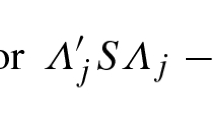Abstract
A special case of Bloxom's version of Tucker's three-mode model is developed statistically. A distinction is made between modes in terms of whether they are fixed or random. Parameter matrices are associated with the fixed modes, while no parameters are associated with the mode representing random observation vectors. The identification problem is discussed, and unknown parameters of the model are estimated by a weighted least squares method based upon a Gauss-Newton algorithm. A goodness-of-fit statistic is presented. An example based upon self-report and peer-report measures of personality shows that the model is applicable to real data. The model represents a generalization of Thurstonian factor analysis; weighted least squares estimators and maximum likelihood estimators of the factor model can be obtained using the proposed theory.
Similar content being viewed by others
References
Anderson, T. W., & Rubin, H. Statistical inference in factor analysis.Proceedings of the Third Berkeley Symposium on Mathematical Statistics and Probability, 1956,5, 111–150.
Bentler, P. M. Multistructure statistical model applied to factor analysis.Multivariate Behavioral Research, 1976,11, 3–25.
Bloxom, B. A note on invariance in three-mode factor analysis.Psychometrika, 1968,33, 347–350.
Browne, M. W. Generalized least square estimators in the analysis of covariance structures.South African Statistical Journal, 1974,8, 1–24.
Carroll, J. D., & Chang, J. J. Analysis of individual differences in multidimensional scaling via an N-way generalization of “Eckart-Young” decomposition.Psychometrika, 1970,35, 283–319.
Greenstadt, J. On the relative efficiencies of gradient methods.Mathematical Computation, 1967,21, 360–367.
Jennrich, R. I., & Sampson, P. F. Application of stepwise regression to nonlinear estimation.Technometrics, 1968,40, 63–72.
Jöreskog, K. G. Some contributions to maximum likelihood factor analysis.Psychometrika, 1967,32, 443–482.
Jöreskog, K. G. Analysis of covariance structures. In P. R. Krishnaiah (Ed.),Multivariate analysis III. New York: Academic Press, 1973, pp. 263–285.
Jöreskog, K. G., & Goldberger, A. S. Factor analysis by generalized least squares.Psychometrika, 1972,37, 243–260.
Jöreskog, K. G., Gruvaeus, G. T., & van Thillo, M.RB-70-15: ACOVS, a general computer program for the analysis of covariance structures. Princeton, N.J.: Educational Testing Service, 1970.
Lee, S. Y.Some algorithms for covariance structure analysis. Unpublished doctoral dissertation, University of California, Los Angeles, 1977.
Marquardt, D. W. An algorithm for least squares estimation of nonlinear parameters.SIAM Journal, 1963,11, 431–441.
Thurstone, L. L.Multiple factor analysis. Chicago: University of Chicago Press, 1947.
Tucker, L. R. Some mathematical notes on three-mode factor analysis.Psychometrika, 1966,31, 279–311.
Author information
Authors and Affiliations
Additional information
This investigation was supported in part by a Research Scientist Development Award (K02-DA00017) and a research grant (DA01070) from the U. S. Public Health Service. The very helpful comments of several anonymous reviewers are gratefully acknowledged.
Rights and permissions
About this article
Cite this article
Bentler, P.M., Lee, SY. Statistical aspects of a three-mode factor analysis model. Psychometrika 43, 343–352 (1978). https://doi.org/10.1007/BF02293644
Received:
Revised:
Issue Date:
DOI: https://doi.org/10.1007/BF02293644




